
Senecio aphanactis, known by the common names chaparral ragwort, rayless ragwort, and California groundsel, is a species of flowering plant in the aster family.

Packera bernardina is a rare species of flowering plant in the aster family known by the common name San Bernardino ragwort.

Packera bolanderi is a species of flowering plant in the aster family known by the common names Bolander's ragwort and seacoast ragwort. It is native to the west coast of the United States from Washington to northern California, where it grows in wet coastal forests and woodlands. There are two varieties of the species which differ slightly in morphology and habitat occupied; these varieties have been considered separate species by some authors. The var. bolanderi has thicker leaves, occurs farther south, and occupies more open types of habitat, than does var. harfordii. This plant in general is a perennial herb producing one to three stems up to half a meter tall. The basal leaves have blades up to 12 centimeters long which are divided into several lobes and borne on long, thin petioles. Leaves growing farther up the stem are smaller and have more lobes on their blades. The inflorescence contains several flower heads, each lined with dark green phyllaries. The head contains many golden yellow disc florets and generally either 8 or 13 yellow ray florets each over a centimeter long. The fruit is an achene tipped with a pappus of bristles.

Packera breweri is a species of flowering plant in the aster family known by the common name Brewer's ragwort. It is endemic to central California, where it occurs in the woodlands and grasslands of the Central Coast Ranges. They are more frequently found in mid-southern counties of California near the coast, such as Kern or Monterey.
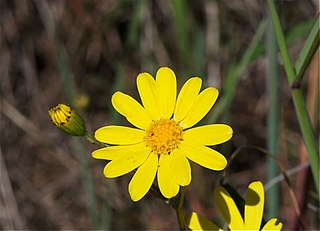
Senecio californicus is a species of flowering plant in the aster family known by the common name California ragwort.
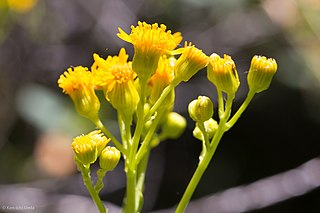
Packera clevelandii is an uncommon species of flowering plant in the aster family known by the common name Cleveland's ragwort. It is endemic to California, where it is known from only two small regions, a section of the North Coast Ranges around Napa County and a part of the Sierra Nevada foothills on the opposite side of the Sacramento Valley. The plant grows in shrubby chaparral on serpentine soils.

Packera subnuda is a species of flowering plant in the aster family known by the common names Buek's groundsel and cleftleaf groundsel. It is native to western North America from the Northwest Territories to northern California to Wyoming, where it grows in high mountain meadows in subalpine and alpine climates.

Packera greenei is a species of flowering plant in the aster family known by the common name flame ragwort. It is endemic to northern California, where it is known from the North Coast Ranges and southern Klamath Mountains. It is a resident of dry mountain scrub habitat, often on serpentine soils.

Senecio hydrophiloides is a species of flowering plant in the aster family known by the common names tall groundsel and sweet marsh ragwort. It is native to western North America from British Columbia and Alberta to northern California to Utah, where it grows in wet meadows and similar habitat. It is a biennial or perennial herb producing a single erect stem or a cluster of a few stems which may exceed one meter in maximum height. The plants are green to red in color and usually without hairs, but new growth can be woolly. The leaves are lance-shaped to oval with toothed edges, the blades up to 25 centimeters long and borne on long winged petioles. The leaves are firm and sometimes a bit fleshy. The inflorescence is a loose or dense cluster of up to 30 or more flower heads lined with black-tipped phyllaries. They contain many yellowish disc florets at the center and often have some yellow ray florets, though these are sometimes absent. Senecio Hydrophiloides can cause Dermatitis.
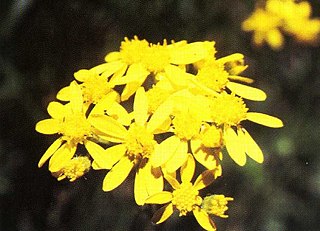
Senecio hydrophilus is a species of flowering plant in the aster family known by the common names water ragwort and alkali-marsh ragwort. It is native to western North America from British Columbia to California to Colorado, where it grows in swampy places such as marshes. It can grow in standing water, including alkaline and salty water. It is a biennial or perennial herb producing a single erect stem or a cluster of a few stems which may exceed one meter in maximum height, at times approaching two meters. The stem is hollow, waxy in texture, and often pale green in color, and it emerges from a small caudex. The thick leaves are lance-shaped to oval with smooth or toothed edges, the blades up to 20 centimeters long and borne on petioles. Smaller leaves occur farther up the stem. The inflorescence is one or more large, spreading clusters of many flower heads. They contain many yellowish disc florets at the center and sometimes have small yellow ray florets as well.

Packera indecora is a species of flowering plant in the aster family known by the common names elegant groundsel and rayless mountain ragwort. It is native to northern North America including most of Canada and sections of the northernmost United States. It grows in moist mountain habitat, such as streamsides and meadows.

Packera ionophylla is an uncommon species of flowering plant in the aster family known by the common name Tehachapi ragwort. It is endemic to California, where it is known from the Tehachapi Mountains, the San Gabriel and San Bernardino Mountains, and Alamo Mountain near the Grapevine. It grows in mountain forest habitat.
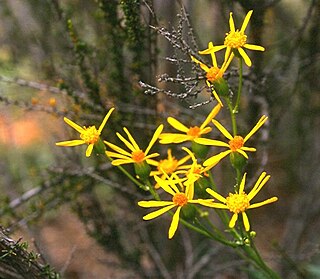
Packera layneae, known by the common name Layne's ragwort and Layne's butterweed, is a rare species of flowering plant in the aster family.

Packera macounii is a species of flowering plant in the aster family known by the common name Siskiyou Mountains ragwort. It is native to the west coast of North America from British Columbia to far northern California, where it grows in chaparral and mountain forests, often on serpentine soils.

Senecio mohavensis, known by the common name Mojave ragwort, is a species of flowering plant in the aster family.
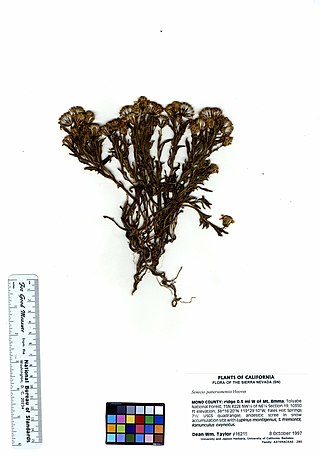
Senecio pattersonensis is an uncommon species of flowering plant in the aster family known by the common names Mono ragwort. and Mount Patterson senecio.
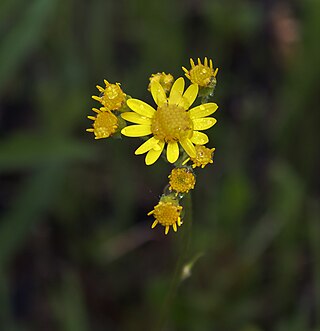
Packera pseudaurea is a species of flowering plant in the aster family known by the common name falsegold groundsel. It is native to North America, where it can be found in western and central parts of Canada and the United States. It grows in mountain habitat such as meadows, streambanks, and woodlands.

Packera streptanthifolia is a species of flowering plant in the aster family known by the common name Rocky Mountain groundsel. It is native to western North America from Alaska to California to New Mexico, where it can be found in mountain habitat including woodlands and rocky slopes.
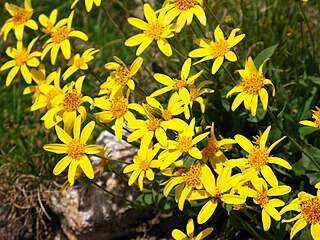
Packera werneriifolia, known by the common names alpine rock butterweed and hoary groundsel, is a species of flowering plant in the aster family. It is native to the western United States in the Sierra Nevada mountain habitat in subalpine and alpine climates, including forests and barren talus.

Packera franciscana is a rare species of flowering plant in the aster family known by the common name San Francisco Peaks groundsel, or San Francisco Peaks ragwort. It is endemic to Arizona in the United States, where it is known only from the San Francisco Peaks in Coconino County. It is threatened by recreational activities in its habitat. It is a federally listed threatened species of the United States.





















